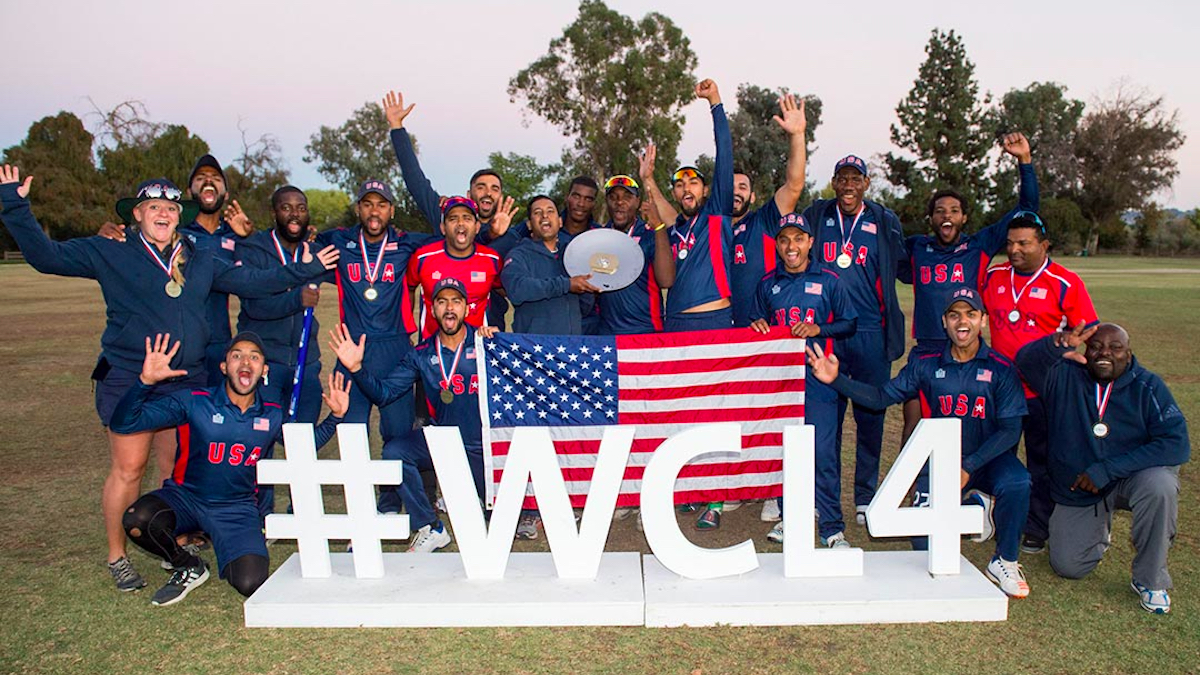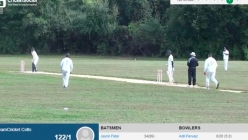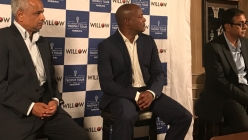Cricket Challenges & Opportunities
USA Cricket - A Roadmap for the Future
2018 Apr 06 by DreamCricket USA

By Venu PalaparthiIf ads on Willow offer any clues, cricket fans also have a propensity to consult an astrologer, look for cheap ways to send money to their parents, are complete suckers for insurance, are so socially awkward that they would die single if it weren't for those matrimonial sites, and bring their office colleagues home for dinner with scant notice. More pertinently, cricket viewers are the only group of sports fans in America that are untouched by Toyota, Budweiser, Gillette, Mastercard, Gatorade or Nike. Yes, the staples of advertising on other sports channels are totally missing from the cricket channels.
You probably read the announcements this past week that Star Sports dropped $944 million on worldwide rights for five years of Indian cricket. This was in addition to the $2.55 billion Star paid last year for five years of IPL rights. Rights for the remaining cricketing nations were sold for $2.6 billion to various broadcasters over the last 5 years. All of this adds up to $1.5 billion per year from broadcast rights alone globally. A good chunk of that money is deployed for cricketing activities in full member countries. That got me thinking. Where does USA fit in all of this?
Granted, USA is decidedly a third world cricket economy. As such, we have underperformed in the important areas of finding and developing revenue streams. Historically, the U.S. national governing body has relied heavily on ICC dole and generated very little non-ICC revenue. Until 2015, the amount of spend on the development and preparation of national teams, directly or indirectly, was a paltry $0.5 million per annum, often less. Much of that money was thanks to ICC grants.
In my estimate, the overall cricket economy in the U.S. is roughly $50 million per annum but don't get too excited. A little over $20 million of that can be attributed to cricket streaming, internet-based services and related advertising. About $10 million is spent by leagues and clubs on facilities, such as field rentals, and for other aspects of organized cricket such as insurance, cricket balls and umpiring fees. About $10 million is the annual expenditure on cricket equipment by individual members. The remainder is accounted for by expense items such as travel and food, and that includes the occasional destination events such as CPL or the All Stars game.
What does this all mean? Very simply, it means that we contribute in the range of $20 million to the full members' pockets and we spend another $20 million of our own money for facilities and grassroots activities locally. Despite living in capitalist America, we have failed to harness cricket's commercial potential. For our own national teams' development, we depend on ICC. This is a terrible report card for the country that put cricket through business school. Wasn't it Mark Mascarenhas, a Connecticut man, who showed cricket boards how to monetize the sport?
And yet, there is hope. Things are changing. Pretty soon, we will have a new organization, USA Cricket, running cricket in this country. USA Cricket will need to find its own footing and it will need to spend a lot more on development. It needs to set goals and implement plans that are reflective of USA's appetite for sport and its capacity to invest.
This article explores the revenue potential for cricket in the U.S. using some well known commercial indicators. I have used available broadcast data, demographic data, data from other similarly situated member countries, and data from other similar-sized sports to arrive at a model for sizing up cricket. And since cricket's economics are closely tied to the national team's fortunes and priorities, I also took a stab at drawing a roadmap for the future of USA cricket. This is DreamCricket's thesis. It has its flaws but it is a starting point.
Counting cricket fans and viewers. And what does this all mean for USA Cricket: The U.S. broadcast market is no small fry. But much of the money ends up lining the pockets of other cricketing nations. According to Willow TV, over 1.4 million households tuned in to watch the last ICC T20 World Cup in 2016. That is over $14 million in revenue from one event. ESPN is on record stating that over 100,000 had paid the roughly $100 ticket price to view the 2015 ICC World Cup on ESPN3. Of course, ten times that number grabbed the 2015 stream for free on spam-laden pirate sites. The more sophisticated fans that craved for high-quality streams paid INR20 and VPN'd into their home countries. As I estimated above, the overall size of the cricket streaming market in the U.S. is in the area of $20 million per annum. This is not a true measure of the actual size of the market. There is plenty of appetite yet. Richer content and easier access will inevitably result in more people wanting to join the network. And that will only amplify the network effect.
Let's examine Willow for a minute. Since its inception in 2002, Willow has made continuous improvements to its distribution, accelerated greatly by its acquisition of Neo in 2013. Willow is available a la carte or bundled, via satellite or cable, and it is also available via the internet for those that have cut the cord. According to the Wall Street Journal, it was already available in over 5 million homes at the start of 2016. Willow said at the time of its acquisition by Bennett Coleman and Co that it expects to scale up to 15 million over the next several years (more on this 15 million number below).
Heck, when I first came to the country, one had to be a bona fide satellite technician to watch any cricket on TV. For the 1996 World Cup, I drove to New Haven where someone had rigged up a TV to a university owned satellite dish.
In time, content proliferated and the devices got complex. You needed to be a millionaire to get your cricket year-round. We had Neo on cable, Willow on satellite, ESPN360 for which you were at the mercy of your cable provider, and Yupp and the rest were on the internet as well but accessible through devices that required a degree from MIT to figure out. These days, you can subscribe to Willow, HotStar and YuppTV without having to mortgage your home. You can toggle away between the three if you care. And you can consume the streams on TV, iPad and your mobile. On the content front, there is a lot more of it on Willow than the other channels. The bottomline, watching cricket has become super easy. Technology and marketplace have a way of sorthing these things out.
Let's look at the demographics, more specifically buying power. According to Pew Research, the Indian diaspora, which is the biggest cricket market, has the highest median household income for any minority group, coming in at $100,000 per household. That is $ 230 billion of aggregate income for the estimated 2.3 million Indian households. Not to forget their influence on purchases made at their companies. They are also the most entrepreneurial - according to Kauffman Foundation Report, 33% of all immigrant founded start-ups in the U.S. have Indian founders. According to The Economist, "they are younger, richer and more likely to get married and supremely well educated." And that is just the 4 million strong Indian diaspora.
The median household income for the larger cricket-fan diaspora in the U.S. is about $70,000. That is comprised of roughly 4 million Indian Americans, 3 million West Indies Americans, 0.8 million UK and Ireland born, 0.5 million Pakistani Americans, 0.2 million Bangladeshi Americans, 0.3 million from the African cricketing nations of South Africa, Zimbabwe, Kenya and Uganda, 0.1 million from Australia and NZ, and 0.1 million from Sri Lankan and other Asian cricketing nations. In aggregate, that adds up to 9 million cricket fans. I have seen ESPN, Leverage and the ICC suggest that there were 15 million cricket fans in this country. That number has its roots in a study that Columbia University did in 2009. As can be seen from Pew's research, the actual number of cricket fans is probably closer to 8-9 million. Collectively, all of these folks earn half a trillion dollars a year.
These cricket lovers like a lot of things that you and I do - luxury cars, vacations over spring break, eating out, gadgets and entertainment. And yet, if ads on Willow offer any clues, cricket fans also have a propensity to consult an astrologer, look for cheap ways to send money to their parents, are complete suckers for insurance, are so socially awkward that they would die single if it weren't for those matrimonial sites, and bring their office colleagues home for dinner with scant notice. More pertinently, cricket viewers are the only group of sports fans in America that are untouched by Toyota, Budweiser, Gillette, Mastercard, Gatorade or Nike. Yes, the staples of advertising on other sports channels are totally missing from the cricket channels.
The main points of this scenic detour are (a) cricket has a large and wealthy audience (b) at the current price point, the viewership numbers have room for growth to perhaps 5 million, maybe more, especially around major events (c) and less importantly, cricket viewers are served terrible ads and crave for the mainstream advertiser.
Still, you wonder, all of this only enriches full-member cricket boards. How will this benefit the U.S. market? Can we sell anything to these viewers that will generate revenue for U.S. cricket? That is the $64,000 question. In the paragraphs that follow, I will explore both the intangible and the potential monetizable value of this vast broadcast base and the pathway to cricketing heaven.
 True worth of the U.S. fan base: I have often spoken about this. The reason for the rapid growth in participation numbers in the U.S. in recent years is because it is easier for the immigrant cricket fan to watch cricket on TV with his partner, friend, or his first-generation son or daughter. This social aspect of watching cricket has tremendous power. Once sucked into watching the sport regularly, the cricket fan is just a few clicks away from buying a backyard cricket kit on the internet, playing cricket at a picnic or on the beach, joining a softball cricket team, or perhaps bringing a kid to a cricket coach.
True worth of the U.S. fan base: I have often spoken about this. The reason for the rapid growth in participation numbers in the U.S. in recent years is because it is easier for the immigrant cricket fan to watch cricket on TV with his partner, friend, or his first-generation son or daughter. This social aspect of watching cricket has tremendous power. Once sucked into watching the sport regularly, the cricket fan is just a few clicks away from buying a backyard cricket kit on the internet, playing cricket at a picnic or on the beach, joining a softball cricket team, or perhaps bringing a kid to a cricket coach. There are even more avenues for the more adventurous cricket crazed mind - joining hardball leagues, coaching at a youth program, joining a corporate league or volunteering to expand ground infrastructure. And for the hardcore fanatic, there are still more intense options. Administering leagues, creating or playing in semi-pro leagues, flying to Florida or to West Indies to attend a big-ticket event, investing time and effort into something more lasting such as varsity cricket or scholarships. We have seen all of these things happen already. And it continues to happen at an astonishing pace. No, I have no evidence to prove causality. Yes, this is all anecdotal. Yes, this is based on my own observations. But I have noticed an uptick in cricket enrollment in my academy immediately following the IPL or a World Cup. And I have hundreds more friends today than I did in 2010 that are actually volunteering 10 or more hours a week for cricket. Those are facts.
So yes, there is the intangible value that broadcast cricket brings to the eco system. Now, let us look at the potential monetizable value.
Revenue potential: If you want to put a value to U.S. cricket's revenue potential, we have to examine the overarching assumption. That broadcast rights are a bellwether for the overall cricketing economy. In a mature cricketing nation, broadcast rights are roughly 80% of the revenue for the governing body. This money is used by the body to fund player salaries, to drive infrastructure development and for overall cricket development. If we apply the bellwether principle, USA Cricket should be a a $20-25 million enterprise today. We know it isn't so today. The reason for that is simple. USA is a consumer of cricket. It produces no original cricket content of its own.
For cricket to realize its potential in this country, USA Cricket needs to find ways to generate original content and host revenue-generating tournaments, allowing it to monetize the 5 million potential cricket viewers and 30,000 registered cricketers. The remainder of the article explores this point and sets some modest goals and timelines.
Three year goals: The first three year goal ought to be to get at least 50,000 of these fans to become fee-paying members of USA Cricket contributing $0.5 million to the national governing body. A second three year goal ought to be to expand its revenue to $5 million in order to support the progress of promising young cricketers. That would allow USA Cricket to fund scholarships and award a small number of player contracts. A third goal would be to get 10,000 of these fans to fill a stadium for two or three international games, essentially a repeat of what we saw when West Indies played India in 2016. A fourth goal would be to find five big name sponsors to underwrite certain grassroots activities.
Four to five year goals: The first five year goal ought to be to get the registered member count to 500,000. The second goal ought to be to start a semi-pro league where players are paid salaries and fans get out and watch games regularly.
If the pro cricket league can get 175,000 of these fans and followers to watch at least one game a year from the stands, and just 25,000 of them to subscribe to live coverage of that league for $25 for an annual pass, cricket will have achieved the same stature as lacrosse. That will also enable cricket to break into the Top 10 team sports in the U.S. Lacrosse's professional leagues pay their players salaries in the $25,000 to $30,000 range and games average roughly 7000 spectators. Lacrosse has TV partnerships and big name sponsors and it is a college sport, even if it is predominantly in the North East and Mid-Atlantic states. Above all, it is the fastest growing sport in the country. US Lacrosse has has a $20 million budget and a $4 million endowment. Cricket will have to find a similar niche and expand from there.
Cricket must aspire to become a $20 million sport in five years and qualify for the 2023 World Cup. This is eminently doable but it takes planning and execution.
The roadmap:
It is one thing to dream about USA in the 2023 World Cup, but it is quite another to actually get there. Because cricket has a complicated WCL and WCQ structure that we must fit into. Similarly, if we want a semi-pro league, it takes a 3-5 years to get basic infrastructure physicalized. And lastly, USA cricket also needs the cooperation of full members to accomplish some of these goals, which means no more suspensions and shenanigans. .
So what does a more granular roadmap look like for cricket? This question has confounded the custodians of U.S. cricket for many years. Unable to adjust to the hard reality of incremental but aggressive growth, they tried to find short cuts. Starting 2007, the erstwhile rulers of U.S. cricket announced six very large multi-million dollar commercial deals that were supposed to shower untold riches and pave our pavilions in gold. Time and again, they put the cart before the horse. Not surprisingly, none of these commercial deals came to fruition. Not one.
In my assessment, there is only one way to realize U.S. cricket's potential - take the long and hard road but constantly think forward. Install a new and robust administration, enhance governance, focus on implementing a decent small 3000-seater stadium infrastructure in four or five cities with room for temporary seating, host a bunch of ICC events, perhaps throw in a couple of tournaments featuring full-member countries, partner with pro T20 leagues such as IPL and bring some mighty T20 action to the fans, find a stable commercial partner who commits to an organic but sustainable semi-pro league. This is not going to happen overnight nor is it going to be easy.
From a national body standpoint, if we must need some markers or milestones to get motivated, here are some real-world examples that we might emulate. Year 1: Singapore Cricket. Year 2: Cricket Scotland. Year 3: Cricket Ireland. Year 4: Afghanistan + semi-pro/pro league. Year 5: Broadcast revenue and World Cup entry.
2018-19 Goal - Think Singapore Cricket: Singapore Cricket has over 2000 registered cricketers that play for some 150 teams. It conducts a schools tournament and has a youth development program that is delivered in three phases. Compared to the U.S., Singapore Cricket is very modest in size, somewhat ambitious in scope, and is exactly in the same division (Division III) as the U.S. in the World Cricket League. The one area that U.S. needs to focus on early is financial stability. Singapore operates on a $2 million budget and spends nearly all of it on its activities, on development and on national team expenses. Only about 10% of the revenue is spent on administrative expenses. The body's funding sources include the private sector and it has a healthy cash reserve of over $1 million. Since U.S. is starting with a blank canvas, these numbers should be achievable in its first year. The target for the first year is 2000 fee-paying registered cricketers, 150 fee-paying organizational members and a $2 million revenue base from all sources. Finally, when WCL Division III tournament is held later this year, it is finally time to win the division and dig ourselves out of the rut.
2019-20 Goal - Think Cricket Scotland: Once out of Division III, US will play Division II next year. A top two finish there will put us on par with Scotland. Scotland is in the top division of WCL and has some 250 clubs and some 17,000 registered participants. Its fan base is estimated to be about 40,000 and it has some 350 schools playing cricket. Scotland earned ODI status until 2022. That makes it eligible for more ICC money. Scotland failed to qualify for the World Cup this year but finished fourth in the World Cup Qualifiers. The country hosted New Zealand A and Zimbabwe in 2017 and has plans for more such tournaments on its soil. If you look at U.S. cricket history, it has hosted New Zealand, India and West Indies but hasn't played them. As an ODI country, it could play some of those teams. By year 2, U.S. will also need to match Scotland's annual budget which is in the $3 million range.
2020-2021 Goal - Think Cricket Ireland: This would be yet another incremental step for U.S. Cricket Ireland is one step ahead of Scotland having attained Test status in 2017. Ireland had 56,000 registered cricketers and roughly 600,000 TV viewers. Ireland has played against international sides. Of course, Ireland's unpredictable weather sometimes poses challenges to its ability to host but when it hosts visiting teams, it earns $0.5 million in revenue per game. By year 3, it is hoped that U.S. can increase the number of international games it plays and hosts. That will get U.S. to where Ireland is today. Cricket Ireland has a roughly $5 million budget. In parallel, US by 2021 must have a functioning semi-pro league and players on salaries.
2022 Goal - Think Afghanistan Cricket: Most people don't remember this but USA and Afghanistan started their WCL journey in the 2008 Division 5 tournament in Jersey. The two teams were 2nd in their respective groups at group stage and ended up in the semis. Things unraveled for the U.S. in the semi-final game against Jersey. That changed the entire trajectory for the U.S. in the WCL. Afghanistan on the other hand defeated Nepal in their semi-final and went on to defeat Jersey in the final. In the end, USA was stuck in Division 5 and Afghanistan progressed to Division 4 in 2008. Afghans were undefeated in Division 4 and moved to Division 3. Winning the Division 3 meant a direct ticket to the World Cup Qualifier. Even if they didn't qualify, they were awarded ODI status in 2009. They have not looked back since and are now cricket's very own disruptors, having defeated the mighty West Indies in the latest World Cup Qualifier. Can USA emulate Afghanistan's success through intense training and superior resources? This is not an easy goal but if Afghanistan could do it, so could we. Separately, by year 4, the semi-pro or pro cricket league should be humming along with some home-grown talent thrown in. As noted above, a good goal for this league is to achieve the same attendance (175,000) and viewership (25,000) as the Lacrosse League. This sets the league up for attaining escape velocity.
2023 Goal - Think World Cup: If the U.S. can notch up a win or two, or at least give some full-members a real fight, USA will have arrived on the world scene. Once it attains ODI status, broadcast revenue has a way of exploding. That is when the original goal we set for ourselves of 500,000 registered members becomes a reality. That is when we actually begin monetizing the 3 million cricket fans who watch cricket on TV. That is when we take cricket to where it belongs in this country - restore its status as the pre-eminent bat and ball sport in America. Just like it used to be at the turn of the 20th century.
That is the roadmap. Now, let's go get it done.




